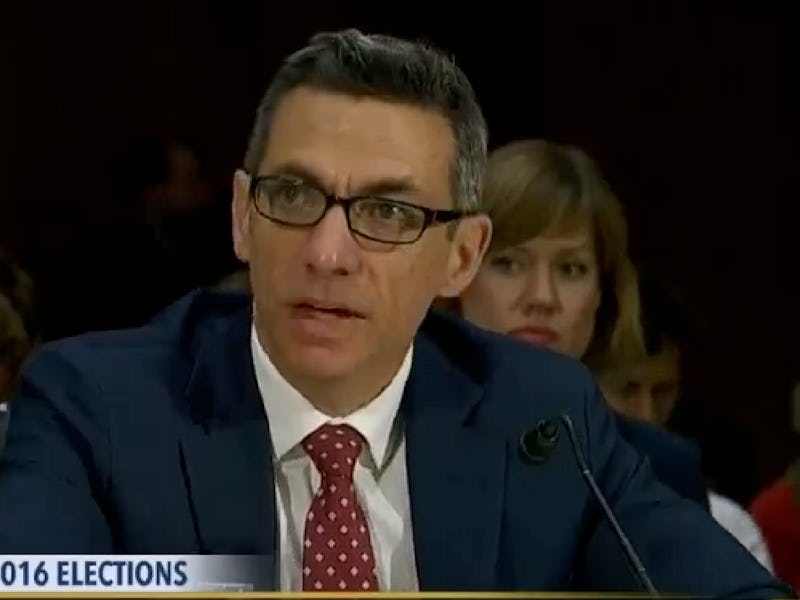The Goal of Russia's Fake News Is to "Topple Democracies"
"What we see today is going to be with us for a long time.'

It’s not common for the U.S. Senate Intelligence Committee to hold an open hearing, but once it got underway on Thursday, the topic was, officially, “A Primer in Russian Active Measures and Influence Campaigns.”
The most damning remarks — if you want to know exactly how fake news works in clear, plain terms, watch it in-full — came from Clinton Watts, a senior fellow at the George Washington University Center for Cyber and Homeland Security.
Watts clinically ran down the reasons for Russia’s so-called “active measures” through digital and traditional media, the Kremlin’s goals for the dissolution of united Western countries and the themes of the measures taken, which read like the ingredients for a civil war.
Questions posed to him from members of the committee resulted in some of the more memorable remarks made to Congress in recent memory.
Senator James Lankford, an Oklahoma Republican on the committee, asked Watts why Russia had so much success interfering with U.S. politics this time around. After all, Russia’s been at the disruption game for decades, since the Cold War.
“I think this answer is very simple and is what no one is saying in this room, which is part of the reason active measures have worked in this election is because the commander-in-chief has used Russian active measures at times against his opponents,” Watts said, calling out President Donald Trump.
Watts offered two specific examples, too (links are ours):
On 14 August, 2016, his campaign chairman, Paul Manafort cited the fake Incirlik story as a terrorist attack on CNN and he used it as a talking point. On 11 October, President Trump stood on a stage and cited what appears to be a fake news story from Sputnik News that disappeared from the internet.
Digital influencing and media manipulation peaked during the 2016 election. “Russian active measures hope to topple democracies through the pursuit of five complementary objectives,” Watts said.
1. Undermine citizen confidence in democratic governance.
2. Create divisive political fissures.
3. Erode trust between citizens and elected officials in their institutions.
4. Popularize Russian policy agendas within foreign populations.
5. Create general distrust or confusion over information sources by blurring the lines between fact and fiction, a very pertinent issue today in our country.
Watts also noted that Florida Senator Marco Rubio, a Republican opponent of Donald Trump in the primary and a member of the Senate Intelligence Committee, saw his campaign targeted by active measures from Russian IP addresses.
“Former members of my presidential campaign team who had access to the internal information of my presidential campaign were targeted by IP addresses with an unknown location within Russia. That effort was unsuccessful,” Rubio told the committee. “I would also inform the committee within the last 24 hours, at 10:45 a.m. yesterday, a second attempt was made, again, against former members of my presidential campaign team who had access to our internal information — again targeted from an IP address from an unknown location in Russia. And that effort was also unsuccessful.”
Later on Thursday, Watts shared this illustration on Twitter of his study on Russian interference in American politics.
All of these active measures add up to what Watts called the Kremlin’s two big goals:
1. The dissolution of the European Union.
2. The breakup of NATO.
“Achieving these two victories against the West will allow Russia to reassert its power globally, pursue its foreign policy objectives bilaterally through military, diplomatic, and economic aggression,” he told the committee.
Watts cited how in the years leading up to the election, Russian active measures took place.
“In late 2014 and throughout 2015, we watched active measures on nearly any disaffected U.S. audience,” Watts said. “Whether it be claims of the U.S. military declaring martial law during the Jade Helm exercise, chaos amongst Black Lives Matter protests, or a stand-off at the Bundy Ranch, Russia’s state-sponsored outlets of RT (Russia Today) and Sputnik News — characterized as “white outlets” — churned out manipulated truths, false news stories, and conspiracies.
All Russian active measures line up under four themes, Watts told the Senators.
1. Political messages designed to tarnish democratic leaders and institutions.
2. Financial propaganda created to weaken confidence in financial markets and capitalist economies.
3. Social unrest, crafted to amplify divisions amongst democratic populaces.
4. Global calamity pushed to insight fear of global demise, nuclear war, or catastrophic climate change.
Fake News
Overt Russian propaganda outlets like the Kremlin-backed RT and Sputnik News, Watts said, are only part of a strategy. There’s a spectrum of English-language websites publishing conspiracy theories. Some “mysteriously operate from Eastern Europe and are curiously led by pro-Russian editors of unknown financing,” Watts said. They “sensationalize these conspiracies in fake news published by white outlets.”
Watts continued:
American-looking social media accounts, the hecklers, honeypots, hackers I described earlier, working alongside automated bots, further amplify this Russian propaganda amongst unwitting Westerners.
Through the end of 2015 and the start of 2016, the Russian influence system began pushing systems and messages, seeking to influence the outcome of the U.S. presidential election.
So how much longer will this go on? Another expert witness testifying before the committee — Eugene Rumer, former intelligence officer for Russia and Eurasia, U.S. National Intelligence Council, 2010-2014 — offered this harsh forecast.
“Mr. Putin is 62, a man in his prime. He’s positioned to run in 2018 again for another six-year term, so I think what we see today is going to be with us for a long time. By the looks of it, the next two presidential terms in this country. So we should base our policy accordingly.”